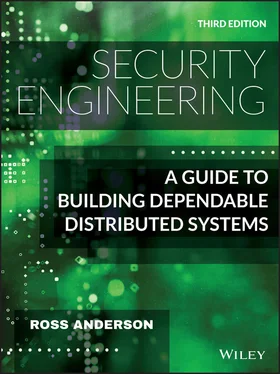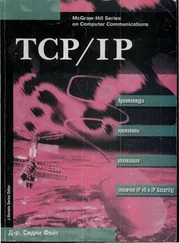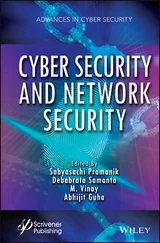Ross Anderson - Security Engineering
Здесь есть возможность читать онлайн «Ross Anderson - Security Engineering» — ознакомительный отрывок электронной книги совершенно бесплатно, а после прочтения отрывка купить полную версию. В некоторых случаях можно слушать аудио, скачать через торрент в формате fb2 и присутствует краткое содержание. Жанр: unrecognised, на английском языке. Описание произведения, (предисловие) а так же отзывы посетителей доступны на портале библиотеки ЛибКат.
- Название:Security Engineering
- Автор:
- Жанр:
- Год:неизвестен
- ISBN:нет данных
- Рейтинг книги:3 / 5. Голосов: 1
-
Избранное:Добавить в избранное
- Отзывы:
-
Ваша оценка:
Security Engineering: краткое содержание, описание и аннотация
Предлагаем к чтению аннотацию, описание, краткое содержание или предисловие (зависит от того, что написал сам автор книги «Security Engineering»). Если вы не нашли необходимую информацию о книге — напишите в комментариях, мы постараемся отыскать её.
secure? Understand how to engineer dependable systems with this newly updated classic
In
Cambridge University professor Ross Anderson updates his classic textbook and teaches readers how to design, implement, and test systems to withstand both error and attack.
This book became a best-seller in 2001 and helped establish the discipline of security engineering. By the second edition in 2008, underground dark markets had let the bad guys specialize and scale up; attacks were increasingly on users rather than on technology. The book repeated its success by showing how security engineers can focus on usability.
Now the third edition brings it up to date for 2020. As people now go online from phones more than laptops, most servers are in the cloud, online advertising drives the Internet and social networks have taken over much human interaction, many patterns of crime and abuse are the same, but the methods have evolved. Ross Anderson explores what security engineering means in 2020, including:
How the basic elements of cryptography, protocols, and access control translate to the new world of phones, cloud services, social media and the Internet of Things Who the attackers are – from nation states and business competitors through criminal gangs to stalkers and playground bullies What they do – from phishing and carding through SIM swapping and software exploits to DDoS and fake news Security psychology, from privacy through ease-of-use to deception The economics of security and dependability – why companies build vulnerable systems and governments look the other way How dozens of industries went online – well or badly <l



 and
and  of
of  – can easily calculate
– can easily calculate  . As
. As  and
and  has no common factors with
has no common factors with  , the key's owner can find a number
, the key's owner can find a number  such that
such that  – she finds the value of
– she finds the value of  separately modulo
separately modulo  and
and  , and combines the answers.
, and combines the answers.  " >(mod
" >(mod  ) is now computed as
) is now computed as  (mod
(mod  ), and decryption works because of Fermat's theorem:
), and decryption works because of Fermat's theorem:

 mod
mod  (thus, using
(thus, using  and
and  as the public signature verification key) and checking that the message
as the public signature verification key) and checking that the message  is recovered:
is recovered:
 that holds among plaintexts, then the same relationship will hold among ciphertexts
that holds among plaintexts, then the same relationship will hold among ciphertexts  and signatures
and signatures  . This property is known as a multiplicative homomorphism ; a homomorphism is a function that preserves some mathematical structure. The homomorphic nature of raw RSA means that it doesn't meet the random oracle model definitions of public key encryption or signature.
. This property is known as a multiplicative homomorphism ; a homomorphism is a function that preserves some mathematical structure. The homomorphic nature of raw RSA means that it doesn't meet the random oracle model definitions of public key encryption or signature. to encrypt the same message to multiple recipients, as this can lead to an algebraic attack. To stop the guessing attack, the low-exponent attack and attacks based on homomorphism, it's sensible to add in some randomness, and some redundancy, into a plaintext block before encrypting it. Every time we encrypt the same short message, say ‘attack’, we want to get a completely different ciphertext, and for these to be indistinguishable from each other as well as from the ciphertexts for ‘retreat’. And there are good ways and bad ways of doing this.
to encrypt the same message to multiple recipients, as this can lead to an algebraic attack. To stop the guessing attack, the low-exponent attack and attacks based on homomorphism, it's sensible to add in some randomness, and some redundancy, into a plaintext block before encrypting it. Every time we encrypt the same short message, say ‘attack’, we want to get a completely different ciphertext, and for these to be indistinguishable from each other as well as from the ciphertexts for ‘retreat’. And there are good ways and bad ways of doing this. that was encrypted to a ciphertext
that was encrypted to a ciphertext  , even if he is allowed to request the decryption of any other ciphertext
, even if he is allowed to request the decryption of any other ciphertext  not equal to
not equal to  [778]. In other words, we want the encryption to resist chosen-ciphertext attack as well as chosen-plaintext attack. There are a number of constructions that give semantic security, but they tend to be too ungainly for practical use.
[778]. In other words, we want the encryption to resist chosen-ciphertext attack as well as chosen-plaintext attack. There are a number of constructions that give semantic security, but they tend to be too ungainly for practical use.









